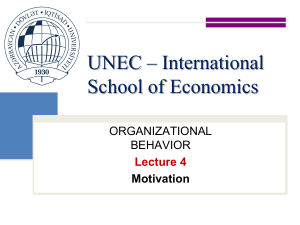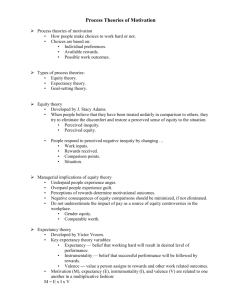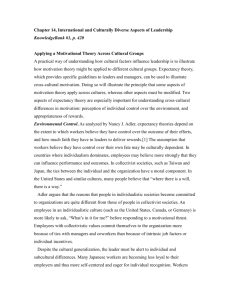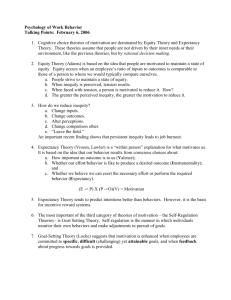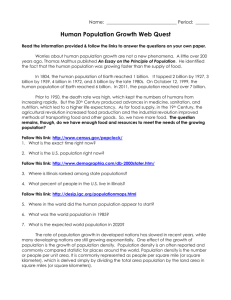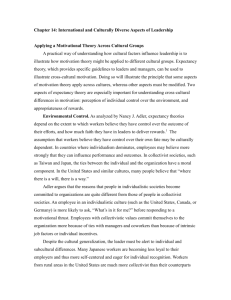Chapter 5: Motivation
advertisement
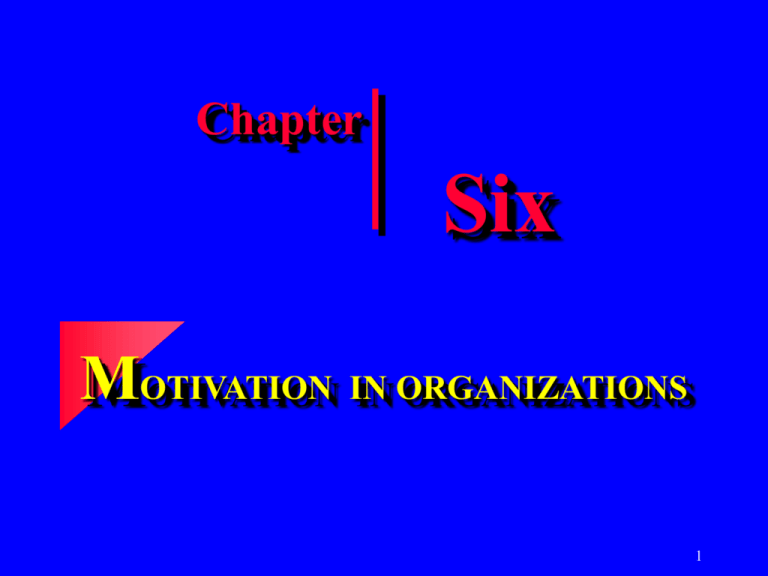
Chapter Six MOTIVATION IN ORGANIZATIONS 1 Motivation Energizes Behavior Drives Compulsions Deprivation/ Disequilibrium Equilibrium Satisfaction Directs Behavior Goals Organization of Effort Reaching Equilibrium Need Drive Sustains Behavior Maintaining motivation Persistance Ability to change course Importance of Feedback Arousal Desire to make a good impression Motivation: Its Basic Components Direction Maintenance Work extra hard Persist Goal Good impression made 3 Need Theories: A Comparison Growth needs 5. Self-actualization needs • Growth needs 4. Esteem needs Deficiency Needs 3. Social needs • Relatedness needs 2. Safety needs • Existence needs 1. Physiological needs Maslow’s need hierarchy theory Alderfer’s ERG theory 4 ERG Theory (Aldefer) Relatedness Needs Existence Needs Growth Needs Satisfaction/Progression Frustration/Regression Satisfaction/Strengthening Discussion: Considering these theories, how might companies motive their employees • What types of incentives would motivate employees • How can employers satisfy employees’ needs • Would the same type of incentives or rewards satisfy all employees? Goal Setting People’s Behavior is Guided by Intentions • Goals provide direction Specific goals are more effective • Goals mobilize behavior Difficult goals generate more effort • Feedback about goal attainment sustains behavior. GOAL SETTING: SOME IMPRESSIVE EFFECTS Percentage of Maximum Weight Carried on Each Trip 100 94 90 Performance at the goal level was sustained seven years after the goal was first set 80 70 60 There was a dramatic improvement in performance after a goal was set 50 1 2 3 4 5 6 7 8 9 10 11 12 Before goal After Goal Seven Years Later Four-Week Periods 11 Goal Commitment Publically stated goals + High nAch + Internal Locus of Control Commitment to Goals Goal Setting Applications • Management by Objectives (MBO) – Performance review procedure by which employees and managers jointly make goals for next review period. They also work out the details for reaching those goals. Performance is regularly monitored. • Organizational Behavioral Management (OBM) (remember learning theory?) – Application of goal setting (or other behavioral science technology) to change the behavior of large units within the organization • Logging example Distributive Justice: Perceptions of how fairly rewards are distributed Theory 1: Exchange Theory If Inputs = Outputs Effort, Motivation, Performance, Skills, Expertise Rewards Bonus Promotions Pay Raise Recognition Satisfaction O =1 I Theory 2: Equity Theory -Compare I/O ratios to others Self Other Outcome Outcome = Input Input Satisfaction Examples of Equity 1. 2. Self Other Self Other 4 4 4 8 4 4 4 8 3. Self Other 4. Self Other 5. Self Other 4 4 4 8 2 4 2 2 2 4 4 8 Examples of Inequity 1. Underpayment = Self O/I < Other O/I Example Self 4 4 Other 8 4 2. Overpayment = Self O/I < Other O/I Example Self 4 4 Other 2 4 POSSIBLE REACTIONS TO INEQUITY: A SUMMARY TYPE OF REACTION Behavioral (what you can do is...) Psychological (what you can think is...) Overpayment inequity Raise your inputs (e.g., work harder), or lower your outcomes (e.g. work through a paid vacation) Convince yourself that your outcomes are deserved based on your inputs (e.g., rationalize that you work harder than others and so you deserve more pay) Underpayment inequity Lower your inputs (e.g., reduce effort), or raise your outcomes e.g., get a raise in pay) Convince yourself that others’ inputs are really higher than your own (e.g., rationalize that the comparison worker is really more qualified and so deserves higher outcomes) Type of Inequity 14 Employee Theft: A Reaction to Underpayment Theft Rate percentage of unaccounted for loss of property Employees of the factories in which there was a pay cut Employees of the factories in which there was no pay cut 9 Employee theft was greatest in factories whose employees experienced a cut in their pay. 8 7 6 5 4 Theft rates were identical before pay was cut in one of them. Theft rates were identical after pay was restored to normal levels. 3 2 1 0 Before Pay Cut During Pay Cut After Pay Cut 15 Procedural Justice • Perceived fairness of the processes by which organizational decisions are made – Voice: giving employees a say in how decisions are made – Error correction: allow opportunity for errors to be corrected – Consistently apply rules and policies – Bias suppression Interactional Justice • Quality of interpersonal treatment (by supervisor) when decisions are made and communicated – Information justification: thoroughness of information received about at decision – Social sensitivity: amount of dignity and respect demonstrated in the course of presenting an undesirable decision. Applications of Justice Theories • Employee Selection • Pay systems – Two-tier wage structures – Pay secrecy • Participative Decision Making • Downsizing Expectancy Theory People will be motivated to engage in a behavior (make a choice) to the degree that they believe that the behavior will lead to a valued outcome Expectancy Theory: An Overview Effort Expectancy Performance X Instrumentality Rewards Skills and abilities Motivation Job Performance X Valence of Rewards Role perceptions and opportunities 16 Expectancy Model: Components Expectancy: The degree to which you expect that hard work (effort) will lead to good performance or high accomplishments Instrumentality: The perception that if you perform well you will be rewarded Valence: How much do you value the rewards you may receive Expectancy Theory, con’t • Force: the motivation to choose a particular course of action. Force E (V * I ) Where: E= Expectancy (probability that effort leads to performance) V=Valence (rating of how satisfying various rewards will be) I=Instrumentality (relationship between taking this option and gaining this reward) Example: Choose between Job A vs. Job B • 1. What are the possible outcomes I would get from getting a job, and how much do I value each of these outcome (Valence) – Good salary 7 – Good Pension 6 – Interesting work 8 – Travel opportunities 4 Valences are measured on a scale from 1 (not at all satisfiying) to 10 (extremely satisfying) Expectancy example, cont • Instrumentality: What is the relationship (subjective correlation) between choosing job A or job B and obtaining this outcome? Instrumentality for Job A High salary .75 Good Pension . .25 Interesting work .50 Travel .75 Instrumentality for Job B .50 .75 .75 .25 Expectancy example, con’t • Expectancy: What is the probability that if I work hard, I will be successful: – In Job A: – In Job B: .40 .70 Force: Which job should I choose Force E (V * I ) Job A: High salary Good Pension Interesting work Travel Valence 7 6 8 4 Instrum. .75 .25 .50 .75 Job B. High salary Good Pension Interesting work Travel Sum Expectancy Force=.40(13.75) = Valence Instrum. 7 .50 6 .75 8 .75 4 .25 Sum Expectancy Force=.70(15.00) = V*I 5.25 1.50 4.00 3.00 13.75 .40 5.5 V*I 3.50 4.50 6.00 1.00 15.00 .70 10.5 Application of Expectancy Theory • Clarify expectancies between effort and performance and follow through with rewards. – Pay for performance – Stock option plans and other incentive programs • Provide valued rewards – Cafeteria-style benefits Motivating Jobs Through Job Redesign • Scientifically managed jobs: boring, repetitive, few skills utilized • Job Enlargement: add more tasks of similar skill level to the job Horizontal Loading • Job Enrichment: add more responsibility and autonomy to the job Vertical Loading Job Enlargement and Job Enrichment: A Comparison Standard Job Enlarged Job Job enlargement adds more tasks at the same level of responsibility. Task 1 (low) Task 2 (low) (low) Number of Tasks (high) (horizontal job loading) Task 3 Number of Tasks (horizontal job loading) (high) Task 1 Task 2 Task 4 (low) Level of Responsibility (vertical job loading) Level of Responsibility (vertical job loading) (high) Level of Responsibility (vertical job loading) (high) Enhanced Job Task 1 Task 2 (high) Job enrichment adds more responsibility to the same number of tasks. (low) (low) Number of Tasks (high) (horizontal job loading) 18 Job Characteristics model Job Characteristics Critical Psyc. States Skill Variety Experienced Meaningfulness of Work Task Identity } Task Significance Autonomy Feedback Responsibility for work outcomes Knowledge of Results Growth Need Strength Job Outcomes Internal work motivation Job satisfaction Growth Satisfaction Low absenteeism High quality performance Enriching Jobs: Some Suggestions From the Job Characteristics Model Principles of Job Description Core Job Dimensions Incorporated 1. Combines jobs enabling worker to perform the entire job Skill variety Task identity 2. Establishes client relationships allowing providers of a service to meet the recipients Skill variety Autonomy Feedback 3. Load jobs vertically allowing greater responsibility an control over work Autonomy 4. Open feedback channels giving workers knowledge Feedback of the results of their work 20

